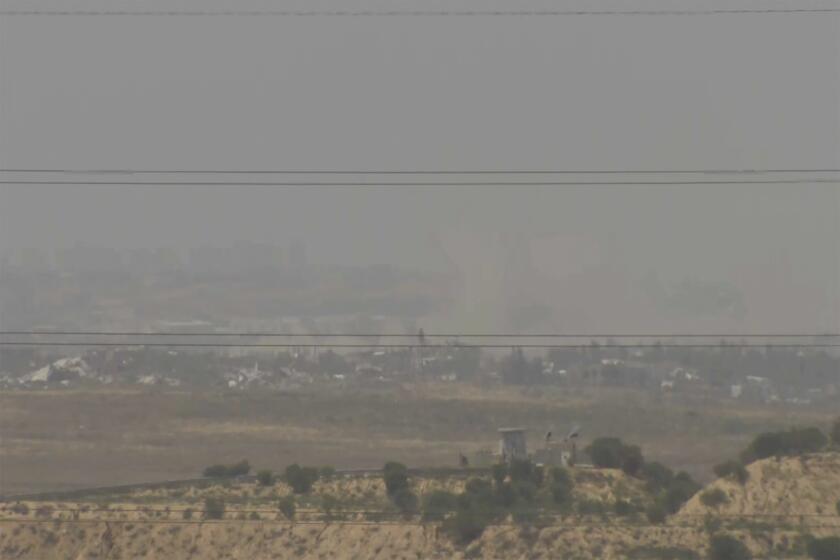Clean-Air Plan Fuels Backstage U.S. Fight
The Clinton administration’s controversial plan to toughen national air pollution standards has sparked a behind-the-scenes eruption of opposition from government agencies, with one predicting that the proposal could bring California’s economic recovery to a grinding halt, administration documents disclose.
The documents reflect wide disagreement within the government over the plan, which was unveiled Nov. 27. Among other things, the internal memorandums and letters question the plan’s scientific basis and complain that the Environmental Protection Agency did not allow sufficient time for broad discussion within the administration. Similar complaints have been made in the public campaign against the air pollution program.
EPA officials responded that the comments reflect the routine give and take that accompanies any difficult, far-reaching government decision, and that they are being taken into consideration before the agency decides, by July 19, whether to adopt the proposed standards or revise them.
The proposed standards were developed under the pressure of a federal court order directing the EPA to determine whether new knowledge about the health effects of air pollution dictated updating the government’s program.
The standards define the concentrations of particles--or soot--and ozone--or smog--that are deemed unhealthful. Cities and states would have until 2002 to develop strategies to counter the pollution and would then have up to 10 years to meet the standards.
The critical comments were disclosed in documents submitted to the House Commerce Committee by eight Cabinet departments and other executive branch offices. The committee’s chairman, Rep. Thomas J. Bliley (R-Va.), has sought to draw attention to complaints raised within various government agencies, which, he has charged, “were virtually shut out” of the plan’s preparation.
The documents included a Department of Transportation analysis of the impact on states of the proposed standards. If the current plan takes effect, the agency warned, California’s “economic recovery . . . could grind to a halt as prospective new industries discover a host of additional air quality obstacles.”
The agency’s memo said areas producing more smog and soot than considered healthy under the proposed standards would face “economically strangling restrictions to daily operations . . . “ These would include controls on truck operations, mandates to reduce pollution-causing auto emissions to zero and requirements that vehicles be run on fuels other than gasoline, the agency said.
The department’s paper also said that as more areas were found out of compliance with the standards, from $800 million to $1 billion in annual funding for transportation projects in California could be delayed.
Loretta M. Ucelli, the EPA’s associate administrator for communications, said that under the Clean Air Act, the agency is required to establish its air pollution standards specifically on health issues. Economic issues are then taken into consideration in setting subsequent regulations intended to attain the air-quality levels.
She said the economic concerns raised by the Transportation Department could be addressed during the 10 years leading up to the standards’ implementation.
Many complaints in the government documents have been echoed publicly by an organized, aggressive campaign of opposition by small businesses and manufacturers’ organizations. Their goal is to drum up sufficient pressure to persuade President Clinton to direct the EPA to sharply modify the plan.
The plan’s private-sector foes have said there is insufficient scientific evidence to support the standards, which are considerably tougher than current air pollution markers still unmet by many communities in California and across the nation.
The Agriculture Department, in its memo, said the standards “are not based on adequate scientific evidence, peer review and interpretation.”
The EPA, however, said the decisions were based on a long list of studies, many of them subject to intensive review by teams of scientists.
The private-sector foes also say the plan’s likely costs outweigh the potential benefits in lives saved or improved, and in reduced medical bills.
Alicia H. Munnell, a member of the president’s Council of Economic Advisers, said in a memo that the projected costs of the program “understate the true costs by orders of magnitude.”
In response, the EPA said the White House economic advisors had not provided any requested documents supporting this position.
The Small Business Administration, in a letter to Carol Browner, the EPA administrator, said the proposal was “one of the most expensive regulations, if not the most expensive regulation faced by small business in 10 or more years.”
But perhaps the most stringent opposition came from the Transportation Department.
Calling for a more deliberate process to determine the new plan, Assistant Transportation Secretary Frank Kruesi said, in a letter, that the measures that would be needed to have communities meet the proposed standards “could have significant economic impacts on industry . . . and require lifestyle changes by a significant part of the U.S. population.”
One EPA official, speaking on the condition of anonymity, said the agency had subjected the proposed standards to “the most intensive interagency review process as we’ve gone through for any regulation.”
Nevertheless, among the complaints was one contained in an e-mail message sent within the Treasury Department. It said the EPA had held “one briefing--albeit a long one--on [Oct. 16] for interested agencies” and that the proposals would only be given “a cursory review” by the Office of Management and Budget before they would be made public.
Ucelli said, however, that the EPA had held a long series of meetings with other agencies, having begun work on the proposal several years earlier, and that the complaint raised in the Treasury Department message was “absolutely incorrect.”
More to Read
Start your day right
Sign up for Essential California for news, features and recommendations from the L.A. Times and beyond in your inbox six days a week.
You may occasionally receive promotional content from the Los Angeles Times.






